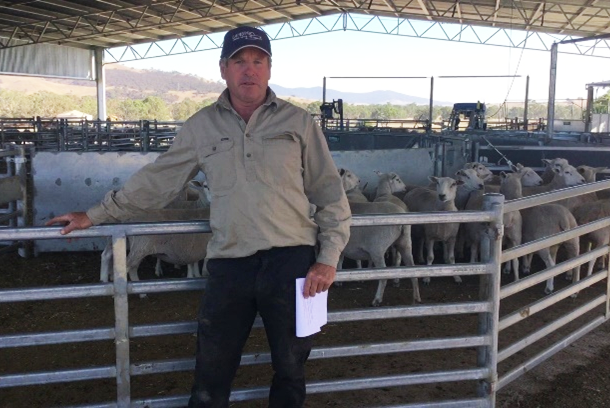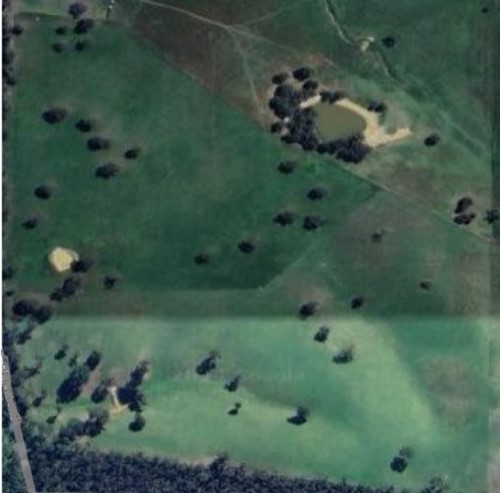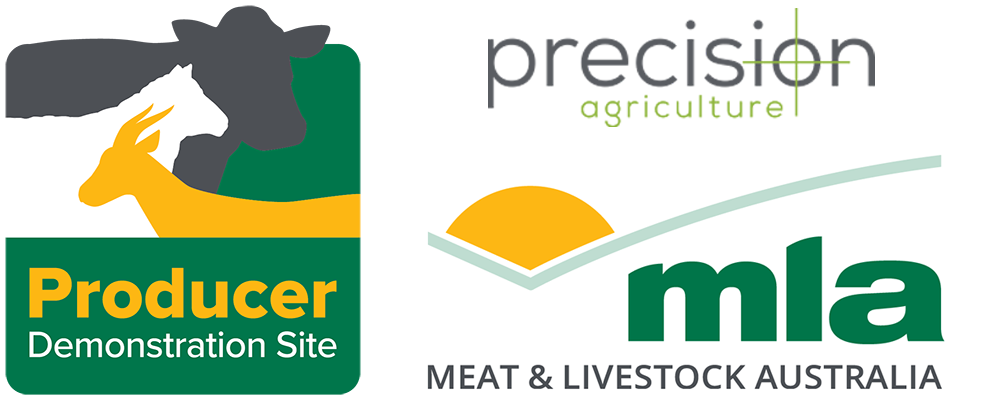Producer case study: Scott, Liz and Daniel Howell
Scott, Liz and Daniel Howell run a prime lamb enterprise at Mt Lonach near Amphitheatre, Victoria. The Howells’ farm was one of 4 properties to take part in the ‘Precision soil mapping in central Victorian pastures’ producer demonstration site (PDS) project. The PDS aimed to demonstrate the potential of grid sampling soil to assess nutrient variability to tailor variable-rate application (VRA) of fertiliser and ameliorants in grazing systems.
Scott became interested in the project after doing previous precision soil testing, which helped them understand the variability of nutrients across their paddocks. He was keen to know if it was economically beneficial to undertake grid sampling and VRA over the whole farm, compared to their existing process of sampling along a transect across the paddock (avoiding sheep camps and under trees), and combining samples for a single soil test.

Soil characteristics and nutrient levels across grazing paddocks can be highly variable due to soil type, stock camps, landscape variation, water movement and management. Grid soil mapping provides a method of testing a paddock for variability in pH and nutrient levels. It is currently the most accurate method for developing VRA, which uses variable rate technology to match fertiliser rates to pasture requirements across an entire paddock. This approach is widely used in the cropping industry but has seen limited uptake in grazing systems in central Victoria.
The site provided an opportunity to map the distribution of soil nutrients across 2 neighbouring paddocks, apply a blanket fertiliser/ameliorant rate to one and VRA to the other (according to specified soil target levels), then re-map nutrients 3 years later to demonstrate the impact of VRA within a dynamic livestock system.
The site
The Howells manage 6,400 Primeline ewes at approximately 14 dry sheep equivalent (DSE) per hectare. The farm is gently undulating and has granite-based sandy loam soil with the potential to leach nutrients.
Pastures consist of perennial rye grass, phalaris and sub-clover, with strategic plantain and chicory included in the system. The Howells also use a feedlot for finishing lambs and strategic containment feeding.
Standard soil testing is completed annually across a subset of paddocks. Nutrient management generally involves applications of 140 kg/ha of single super phosphate (SSP), 60 kg/ha of muriate of potash (MOP) and 10 units of sulfur. Lime is applied every 7 to 10 years as part of the pasture renovation program, which involves a summer fodder crop, followed by 2 years of annual rye grass or clover, then perennial pasture.
Two paddocks used in the demonstration were undulating and had a phalaris/sub-clover base. The control paddock was 11.9 ha in area and the one using VRA technology was 10.9 ha.
The Howells’ site used VRA technology for phosphorus, potassium and lime.

The demonstration
Grid-based soil sampling was used to assess variability in soil nutrients across representative grazing paddocks at each of the 4 host farms. All paddocks were grid soil sampled at 0–10 cm depth at a 1 ha resolution (to best understand in-paddock variability) in December 2020. Soil samples were tested for pH (CaCl2), Olsen phosphorus (P), sulfur and exchangeable cations (potassium [K], magnesium [Mg], sodium [Na] and calcium [Ca]) at an accredited soil laboratory. Subsoil samples were also collected at lower resolution (approximately every tenth grid square, targeted based on initial results) in 0–5 cm, 5–10 cm, 10–15 cm and 15–20 cm increments to allow for identification of any pH stratification issues.
A producer steering committee developed paddock targets to address limitations to pasture production. Paired-paddock demonstrations were established to compare VRA versus the control, which involved conventional blanket applications of key inputs (phosphorus, potassium and lime). Application rates for the conventional applications were determined by the steering committee (using industry ’rules of thumb’), based on a single set of soil test results (the paddock average from grid sample points) to achieve the target level.
Similar management was used across the paired paddocks, including similar grazing strategies.
Return soil sampling was undertaken 3 years later (in 2023) to assess any changes in soil conditions.
Pasture composition, feed on offer (FOO), stocking rate and pasture quality were monitored throughout the project to assess any impact on livestock and pasture production.
Finally, the benefits and costs of using VRA versus conventional blanket (control) applications when applying key pasture inputs were assessed by comparing the costs and relative pasture production (benefits) of the 2 systems.
Table 1 shows starting nutrient levels in 2020.
Table 1: Initial pH (CaCl2), Olsen P (mg/kg) and potassium (mg/kg) for the control and VRA paddocks sampled in 2020
pH (CaCl2) | Olsen P (mg/kg) | Potassium (mg/kg) | |
|---|---|---|---|
Control paddock | 4.6 (4.3–4.9) | 10.7 (8–14) | 121 (77–180) |
VRA paddock | 4.7 (4.5–5.0) | 11.5 (7–17) | 148 (77–208) |
Soil targets for the site included:
- pH of 5.2 (CaCl2)
- Olsen P at 15 mg/kg
- potassium at 150 mg/kg.
Tables 2 and 3 show paddock applications each year, including capital and maintenance fertiliser.
Table 2: Control paddock soil applications (lime, single superphosphate (SSP)
Control paddock | Lime (t/ha) | SSP (kg/ha) | MOP (kg/ha) |
|---|---|---|---|
Year 1 | 2.5 | 140 | 50 |
Year 2 | 150 | ||
Year 3 | 102 | ||
Total | 2.5 | 392 | 50 |
Table 3: VRA paddock soil applications (lime, single superphosphate (SSP) and muriate of potash (MOP)
VRA paddock | Lime (t/ha) | SSP (kg/ha) | MOP (kg/ha) |
|---|---|---|---|
Year 1 | 0.83 (0.5–1) | 234 (100–250) | 47 (0–300) |
Year 2 | 90 (0–250) | 21 (0–200) | |
Year 3 | 118 (0–250) | ||
Total | 0.83 (0.5–1) | 442 (0–750) | 68 (0–500) |
Table 4: Final pH (CaCl2), Olsen P (mg/kg) and potassium (mg/kg) for the control and VRA paddocks sampled in 2023
pH (CaCl2) | Olsen P (mg/kg) | Potassium (mg/kg) | |
|---|---|---|---|
Control paddock | 5.3 (5.0–5.8) | 12 (7–26) | 166 (72–414) |
VRA paddock | 4.9 (4.5–5.3) | 20 (12–58) | 249 (115–744) |
Results
Soil test results
Initial (2020) and final (2023) soil maps are shown in Figure 3 and final soil test results (from December 2023) are shown in Table 4.
Lime
The control received 2.5t/ha, increasing the pH from an average of 4.6 to 5.3 (range of 5.0–5.8). In contrast, the 0.83 t/ha applied to the VRA paddock increased the average pH from 4.7 to 4.9 (range 4.5–5.3), falling short of the pH target of 5.2. The VRA lime rates assumed a high-quality (neutralising value=95%) lime and did not take into account ongoing acidification each year. Lime quality and ongoing acidification in these high-production pastures are likely to have affected the accuracy of the VRA treatment. Both the control and VRA paddocks finished with similar pH variability in the paddock.
Phosphorus
The control paddock received an annual maintenance rate of P over the 3 years, which was not sufficient to increase the Olsen P (average Olsen P initially 10.7, reaching 12) to the target of 15. It is likely that either the capital or maintenance P rate was not included in the first year.
In the VRA treatment, Olsen P levels increased in all but one grid soil sample. The VRA paddock got close to the target Olsen P of 15 across most of the paddock, except for 2 00sheep camps (reaching an Olsen P of 58).
Across both the control and VRA paddocks, stocking rates increased during the demonstration period, increasing the levels of nutrients being exported from the paddock. This higher stocking rate was not accurately accounted for during the calculation of maintenance P, particularly in the final year of the PDS.
The higher stocking rate would also mean more nutrients were transferred across the paddock through dung and urine deposits, particularly to sheep camp areas (identified as yellow, aqua and blue on maps f and h). This caused Olsen P to increase in variability in both the control and VRA paddocks.
Potassium
The control treatment of 50 kg MOP/ha and VRA with an average application of 68kg/ha saw potassium levels increase in just over half of the paddock. Potassium was concentrated in the same areas of the paddock as P, due to stock redistribution of nutrients, reaching 774 mg/kg K at the highest point in the VRA paddock. Once again, the increased stocking rate is likely to have exacerbated nutrient movement within and off the paddocks.
Figure 3: 2020 (left) and 2023 (right) pH (CaCl2), Olsen P (mg/kg) and potassium (mg/kg) soil maps
Pasture response and production
No consistent difference was measured in pasture production, stocking rate, pasture quality or pasture composition between the control and VRA paddocks at each of the 4 sites throughout the demonstration. The Howell’s site recorded an estimated 1.1 t of dry matter (DM)/ha in the VRA paddock over the 3 years; however, this is unlikely to be statistically significant.
Economic outcomes
The economic analysis focused on the costs relative to the pasture production in the VRA and control paddocks. The results presented in Table 5 show large differences in the soil sampling cost between the two treatments, with the 10.9ha VRA paddock equating to $817.50 (compared to a single soil test cost for the control). Outside of project conditions, commercial grazing enterprises are undertaking 2ha grid sampling to best balance sampling costs whilst still providing practical variable rate solutions.
Table 5: Comparison of 3-year (2021 to 2023) costs and pasture growth of the 2 soil management treatments
Control | VRA | |
|---|---|---|
Total soil sampling cost ($/ha) | $7 | $75 |
Total capital fertiliser cost ($/ha) | $159 | $184 |
Total maintenance fertiliser cost ($/ha) | $152 | $70 |
Total treatment cost ($/ha) | $318 | $329 |
Total three year pasture growth (tDM/ha) | 19.6 | 20.5 |
Total treatment cost ($/tDM) | $16 | $16 |
The control paddock had a higher cost of applied nutrients (an extra $57/ha). This was largely attributed to higher amounts of lime, which achieved the pH target in the control. However, any savings from reduced fertiliser/ameliorant application on the VRA paddocks were offset by the high sampling cost of VRA. This, combined with minimal differences in pasture production between the VRA and control paddocks, meant that there was no evidence of any economic benefits of intensive point sampling for soil nutrient management.
These results demonstrate the benefits and costs of additional information. In part, this is a result of the law of diminishing marginal returns to extra inputs. This principle also applies to extra inputs of information to production decisions, as demonstrated by intensive point sampling relative to transect sampling.
Producer feedback
The biggest surprise for Scott was seeing just how much sheep moved nutrients around the farm – both within the paddock and off the paddock (particularly P and K). The soil maps also highlighted the impact of sheep camps and the importance of avoiding these areas when soil testing and spreading fertiliser.
Scott said that while he probably would not continue to grid map the whole farm, taking more than one soil test in a paddock in visually different areas could improve accuracy. However, a plan is needed on how the extra information is used. It may mean, when spreading, avoiding highly fertile areas or using lower or higher rates within a paddock.
His advice to other grazing properties considering precision soil testing was to start small. He said, ‘Try precision soil testing a couple of paddocks first, to get a good understanding of the variation and the lay of the land before considering the whole farm. It’s great to understand your paddock, but it comes at a cost, and you need to weigh this up for yourself.’
Scott said being a host site made him analyse his system a lot harder. ‘You put a bit more effort in, but you get a huge amount more out.’
Summary
- Grid soil sampling provided detailed soil information and identified variability in Olsen P and K, which aligned to landscape differences and sheep behaviour.
- The increased level of soil information came at an increased cost ($75/ha) compared to the control ($7/ha or $84 for one test). However, the grid sampling cost would be significantly less for a commercial 2ha grid approach, at a reduced level of detail.
- Applications of SSP to both the VRA and control (blanket application) fell short of the target Olsen P of 15 mg/kg.
- VRA for SSP and MOP did not reduce paddock variability. The main cause was livestock movement of nutrients into high points in the landscape (stock camps) and nutrient movement off the paddocks due to increased stocking rate. The control paddock SSP rate was underestimated, possibly due to overlooking the maintenance application in Year 1.
- VRA lime applications fell short of the target pH of 5.2, reaching an average of 4.9, whilst the control paddock reached an average of 5.3.
- No obvious or consistent differences were measured in pasture production, quality and composition and stocking rate between the control and VRA paddocks.
- The soil maps showed how landscape and related animal movements (e.g. sheep camps) impact nutrient movement. Increasing the stocking rate can exacerbate nutrient movement.
- Soil sampling approaches (or transects) that avoid stock camps, sample stock camps separately, or focus on separately sampling different land classes can lead to a more accurate understanding of nutrient levels. This in turn enables the development of strategies to address nutrient requirements. Land class fencing and rotational grazing can help to manage nutrient movement by livestock.
- The demonstration highlighted the importance of re-sampling paddocks over time to understand trends and impacts of applications (and animal movements within paddocks and across the farm).
Note that this site demonstrated VRA for lime, gypsum and potassium applications. Different applications were made at other sites with different outcomes.
Acknowledgements

Thanks to Scott, Liz and Daniel Howell (and other site hosts) for allowing the demonstration to be conducted on their property and the Pyrenees and Smeaton BestWool/BestLamb groups for their participation in the project.
For more information, email on-farm-demos@agriculture.vic.gov.au